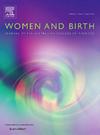A snapshot of Australian midwifery: A workforce survey
IF 4.1
2区 医学
Q1 NURSING
引用次数: 0
Abstract
Background
Midwives are the largest professional group in Australian maternity services. Understanding the current midwifery workforce and the issues midwives face is important for workforce planning.
Aim
Provide detailed understandings of the current Australian midwifery workforce, including potential attrition rates.
Method
Descriptive cross-sectional online survey of registered midwives.
Findings
3286 midwives contributed to the data. Respondents most commonly reported their gender as woman, were aged 40 – 59, worked part-time, and practised in a metropolitan setting. Only 11.8 % of midwives worked in roles where they might provide continuity of midwifery care, yet 37.5 % expressed an interest in working in midwifery group practice. One third (36.6 %) were considering leaving midwifery, for reasons mostly related to their workplace. Poor workplace culture, understaffing, over-medicalisation, and being unable to provide safe midwifery care were commonly reported concerns.
Discussion
This is the largest survey of the Australia midwifery workforce. While most midwives worked in clinical roles in the public sector, the range of roles was extremely diverse. Potential attrition rates are high, which would have a devastating impact on safe maternity care provision in Australia. More midwives want to work in continuity of midwifery carer models than are currently doing so.
Conclusion
Urgent action to improve midwifery workplaces is required to retain midwives and encourage greater workforce participation. Increasing midwifery student intakes, removing barriers to employment in flexible continuity of midwifery carer roles, and improving working conditions will contribute to a stronger future for the Australian midwifery workforce.
澳大利亚助产士概况:一项劳动力调查
助产士是澳大利亚产科服务中最大的专业群体。了解目前的助产士队伍和助产士面临的问题对劳动力规划很重要。目的提供对当前澳大利亚助产士队伍的详细了解,包括潜在的流失率。方法对注册助产士进行描述性横断面在线调查。3286名助产士为该数据做出了贡献。受访者最常见的性别是女性,年龄在40 - 59岁之间,从事兼职工作,在大都市工作。只有11.8% %的助产士在他们可能提供连续性助产护理的角色中工作,然而37.5% %的助产士表示有兴趣在助产小组实践中工作。三分之一(36.6% %)的人考虑离开助产行业,原因主要与工作有关。恶劣的工作场所文化、人员不足、过度医疗化以及无法提供安全的助产护理是普遍存在的问题。这是澳大利亚最大的助产士劳动力调查。虽然大多数助产士在公共部门担任临床角色,但角色的范围非常多样化。潜在的流失率很高,这将对澳大利亚的安全孕产护理产生毁灭性的影响。与目前相比,更多的助产士希望继续从事助产护理模式的工作。结论需要采取紧急行动改善助产工作场所,以留住助产士并鼓励更多的劳动力参与。增加助产学生的入学人数,消除在灵活的助产护理人员角色中就业的障碍,改善工作条件,将有助于澳大利亚助产人员更强大的未来。
本文章由计算机程序翻译,如有差异,请以英文原文为准。
求助全文
约1分钟内获得全文
求助全文
来源期刊

Women and Birth
NURSING-OBSTETRICS & GYNECOLOGY
CiteScore
7.20
自引率
13.20%
发文量
371
审稿时长
27 days
期刊介绍:
Women and Birth is the official journal of the Australian College of Midwives (ACM). It is a midwifery journal that publishes on all matters that affect women and birth, from pre-conceptual counselling, through pregnancy, birth, and the first six weeks postnatal. All papers accepted will draw from and contribute to the relevant contemporary research, policy and/or theoretical literature. We seek research papers, quality assurances papers (with ethical approval) discussion papers, clinical practice papers, case studies and original literature reviews.
Our women-centred focus is inclusive of the family, fetus and newborn, both well and sick, and covers both healthy and complex pregnancies and births. The journal seeks papers that take a woman-centred focus on maternity services, epidemiology, primary health care, reproductive psycho/physiology, midwifery practice, theory, research, education, management and leadership. We also seek relevant papers on maternal mental health and neonatal well-being, natural and complementary therapies, local, national and international policy, management, politics, economics and societal and cultural issues as they affect childbearing women and their families. Topics may include, where appropriate, neonatal care, child and family health, women’s health, related to pregnancy, birth and the postpartum, including lactation. Interprofessional papers relevant to midwifery are welcome. Articles are double blind peer-reviewed, primarily by experts in the field of the submitted work.
 求助内容:
求助内容: 应助结果提醒方式:
应助结果提醒方式:


